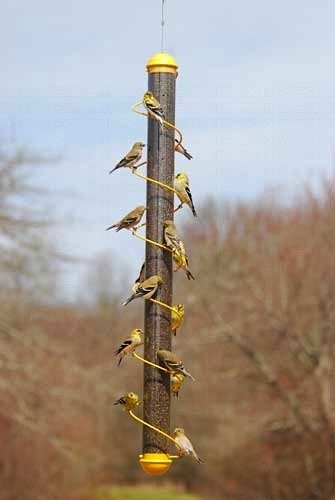cool spirals on these big thistle feeders

Innovative by design with quality construction (no cheezy plastic parts here) these 36-inch tall, large capacity thistle feeders have a cool spiral instead of perches. Featuring more feeder ports, birds really do “run the spiral” hopping from one one port to the next. This opens up space for more birds to join the party, no more waiting around for an open perch to catch some chow!
Goldfinches feed babies thistle (or nyjer) exclusively. Gross as it sounds, parents chew and prepare the tiny black seed, regurgitating it into babies’ mouths. It’s not until juveniles are out in the world that they may start to discover and eat insects. There’s a kind and quiet demeanor about this favored songbird, you’ll rarely catch them squabble at feeders. Rather than fight for a spot, most will give up and maybe try again later. Hanging a few economical thistle socks helps to alleviate this problem during peak season.
In fall when they molt again, their vibrant yellow plumage will give way to new olive drab feathers for fall and winter. It may seem like your Goldfinches have gone on their way and migrated south, but they’re still around! Keep thistle feeders out year-round to accommodate these resident birds, (and fresh water in a bath) and next summer that lemon yellow color will once again grace your yard. So popular these birds are, there’s even a birdhouse modeled after one… although typically they do nest in hedges or trees.

